Training your upper back is a essential part of strengthening and carving your back. Whether you are a workout pro or forming your first training plan, the workouts below will help you meet your fitness goals.
lever one arm bent over row
1. Start by placing the barbell on the ground in front of you. Stand with your feet shoulder-width apart.
2. Bend your knees slightly and hinge forward from your hips, not your waist, to grab the barbell. Keep your back straight and almost parallel to the floor.
3. Hold the barbell with one hand, palm facing towards you. Your other hand can be placed on your hip or hanging down for balance.
4. Pull the barbell up towards your chest, keeping your elbow close to your body. Ensure that you're pulling from your upper back and shoulder muscles, not just your arms.
5. Slowly lower the barbell back down to the starting position. This completes one rep.
6. Repeat the exercise for your desired number of reps. Then switch to the other arm and do the same number of reps.
7. Remember to keep your core engaged and your back straight throughout the exercise. Avoid any jerky movements or using your back to lift the weight. The power should come from your upper back and shoulder muscles.
8. For beginners, start with a lighter weight to ensure you're using the correct form. As you get stronger, you can gradually increase the weight.
lever bent over row
1. Start by placing a barbell on the ground in front of you. Stand with your feet shoulder-width apart, knees slightly bent.
2. Bend at your waist, keeping your back straight, until your torso is almost parallel to the floor. Make sure to keep your head up.
3. Hold the barbell with both hands using an overhand grip. Your hands should be slightly wider than shoulder-width apart.
4. Pull the barbell towards your chest, keeping your elbows close to your body. Ensure that you are pulling with your back muscles and not your arms.
5. Hold the contraction at the top for a second, then slowly lower the barbell back to the starting position.
6. Repeat for the desired number of repetitions.
Remember to keep your back straight and your movements controlled throughout the exercise. Avoid using your lower back or momentum to lift the weight. The focus should be on squeezing your shoulder blades together as you pull the barbell towards your chest.
ez bar reverse grip bent over row
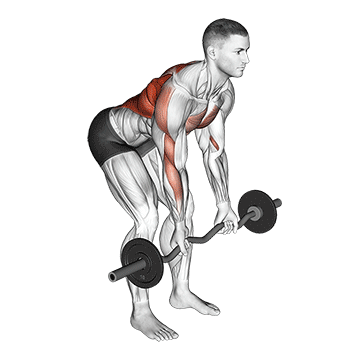
1. Start by standing upright with your feet shoulder-width apart. Hold the EZ barbell with a reverse grip, meaning your palms should be facing forward.
2. Bend your knees slightly and lean forward from your waist. Keep your back straight and almost parallel to the floor. This is your starting position.
3. Pull the barbell towards your upper waist while keeping your elbows close to your body. Ensure to squeeze your shoulder blades together when you pull the barbell up.
4. Hold this position for a second, then slowly lower the barbell back to the starting position.
5. Repeat this movement for your desired number of repetitions.
Remember to keep your core engaged and your back straight throughout the exercise to avoid any injuries. This exercise targets your upper back muscles, including your latissimus dorsi and rhomboids.
cambered bar lying row
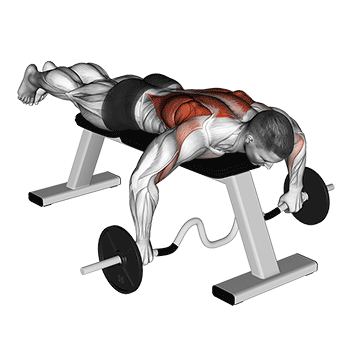
To perform the cambered bar lying row, follow these steps:
1. Start by lying flat on your back on a flat bench with your feet firmly planted on the ground.
2. Hold the cambered barbell with a wider than shoulder-width grip, palms facing towards your feet.
3. Extend your arms fully so that the barbell is directly above your chest. This is your starting position.
4. Keeping your elbows close to your body, pull the barbell towards your upper chest by bending your elbows and squeezing your shoulder blades together.
5. Pause for a moment at the top of the movement, then slowly lower the barbell back to the starting position.
6. Repeat for the desired number of repetitions.
Remember to keep your back flat against the bench throughout the exercise and avoid using your hips or legs to lift the weight. The movement should be controlled, focusing on the contraction and stretch of the upper back muscles.
barbell reverse grip incline bench row
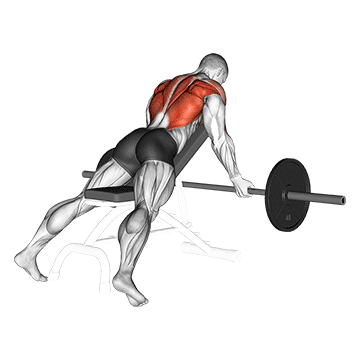
To perform the barbell reverse grip incline bench row, follow these steps:
1. Set up an incline bench at a 45-degree angle and place a barbell on the ground in front of it.
2. Stand facing the bench and bend over to grab the barbell with a reverse grip (palms facing towards you). Your hands should be shoulder-width apart.
3. Position yourself so your chest is resting on the bench, your feet are flat on the floor, and your knees are slightly bent. The barbell should be hanging straight down from your shoulders.
4. Pull the barbell up towards your chest, keeping your elbows close to your body. Squeeze your shoulder blades together at the top of the movement.
5. Slowly lower the barbell back down to the starting position, fully extending your arms.
6. Repeat for the desired number of reps.
Remember to keep your back straight and your core engaged throughout the exercise. Also, ensure that you're pulling the barbell with your back muscles, not your arms. This exercise targets the upper back, but also works the biceps and shoulders.
barbell reverse grip bent over row
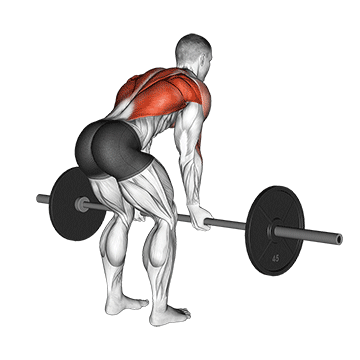
To perform the barbell reverse grip bent over row, start by standing upright with your feet shoulder-width apart. Hold a barbell with a reverse grip, meaning your palms should be facing towards you.
Bend your knees slightly and hinge at the waist, pushing your hips back until your torso is almost parallel to the floor. Keep your back straight and your head in a neutral position. This is your starting position.
Pull the barbell towards your upper waist while keeping your elbows close to your body. Squeeze your shoulder blades together at the top of the movement.
Hold this position for a second, then slowly lower the barbell back to the starting position.
Remember to keep your back straight and your core engaged throughout the exercise.
Repeat this movement for the desired number of repetitions.
This exercise targets your upper back muscles, but also works your biceps and shoulders. Make sure to use a weight that is challenging but allows you to maintain proper form.
barbell pendlay row
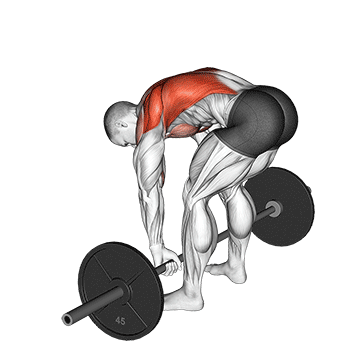
To perform the Barbell Pendlay Row, follow these steps:
1. Stand upright and place a barbell on the floor in front of you. Your feet should be shoulder-width apart.
2. Bend at your hips and knees, and grasp the barbell with an overhand grip. Your hands should be just beyond shoulder-width apart.
3. Keep your back straight and nearly parallel to the floor. This is your starting position.
4. Pull the barbell to your upper waist by retracting your shoulder blades and flexing your elbows. Keep your hips and knees bent throughout the movement.
5. Hold the position for a second when the barbell touches your upper waist. Make sure to squeeze your back muscles at the top of the movement.
6. Lower the barbell back to the floor in a controlled manner, fully extending your arms and shoulders.
7. Repeat for the desired number of repetitions.
Remember to keep your back straight and avoid any jerky movements. The weight should be heavy enough to challenge you, but not so heavy that it causes you to lose form.
barbell one arm bent over row
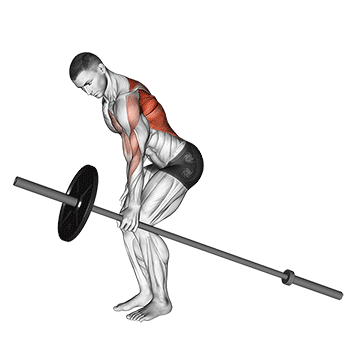
1. Start by selecting a barbell with an appropriate weight that you can lift with one arm.
2. Stand with your feet shoulder-width apart and hold the barbell in your right hand with an overhand grip.
3. Bend your knees slightly and lean forward from your waist until your torso is almost parallel to the floor. Keep your back straight and your left hand on your left knee for support.
4. Let the barbell hang straight down from your shoulder. This is your starting position.
5. Pull the barbell up towards your chest, keeping your elbow close to your body. Ensure that you are using your upper back muscles to lift the weight, not your arm.
6. Hold the position for a second when the barbell is at the highest point, then slowly lower it back to the starting position.
7. Repeat the movement for your desired number of repetitions.
8. Once you have completed your set, switch to your left hand and repeat the exercise.
Remember to keep your back straight and your core engaged throughout the exercise to avoid injury. Also, ensure that you are lifting a weight that is challenging but manageable to maintain proper form.
barbell incline row
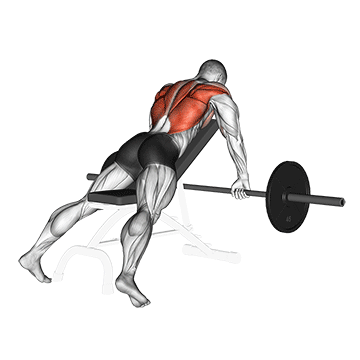
To perform the barbell incline row, start by setting up an incline bench at a 45-degree angle.
1. Stand behind the bench and pick up a barbell using a pronated grip (palms facing down). Your hands should be slightly wider than shoulder-width apart.
2. Bend your knees slightly and lean forward from your hips, maintaining a straight back. Your torso should be almost parallel to the floor.
3. Position yourself so that your chest is resting on the bench and your feet are firmly planted on the ground. The barbell should be hanging straight down from your shoulders.
4. Pull the barbell up towards your chest, keeping your elbows close to your body. Squeeze your shoulder blades together at the top of the movement.
5. Slowly lower the barbell back to the starting position, fully extending your arms and stretching your shoulder blades apart.
6. Repeat for the desired number of repetitions.
Remember to keep your back straight and your core engaged throughout the exercise. Avoid using your lower back or momentum to lift the weight. The movement should be controlled and focused on the upper back muscles.
barbell bent over row
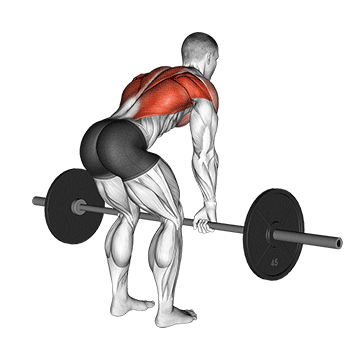
1. Start by standing upright with your feet shoulder-width apart. Hold the barbell with an overhand grip, hands just wider than shoulder-width apart.
2. Bend your knees slightly and hinge at the waist, pushing your hips back until your torso is nearly parallel to the floor. Keep your back straight and your head in a neutral position.
3. Hold the barbell at arm's length directly below your chest. This is your starting position.
4. Pull the barbell towards your upper waist by bending your elbows and squeezing your shoulder blades together. Keep your elbows close to your body and do not let your back round.
5. Pause for a moment at the top of the movement, then slowly lower the barbell back to the starting position.
6. Repeat for the desired number of repetitions.
Remember to keep your core engaged throughout the exercise to protect your lower back. Also, avoid using your lower back or momentum to lift the weight; the power should come from your upper back and arms.
No tags for this post.
